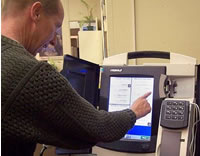
Some educators and activists say the recent consolidation of electronic voting machine ownership in the United States creates a potentially dangerous monopoly, and without greater accountability to voters, they worry that education-related elections that usually have low turnout could be especially affected.
Election Systems & Software (ES&S), the country’s largest voting machine vendor, announced last week the purchase of voting machines from a subsidiary of Diebold Inc., its closest competitor.
ES&S now owns more than 70 percent of the electronic voting equipment in the United States. That means 120 million registered voters will use ES&S machines, while 26 million voters will use equipment from the next-closest provider, Sequoia Voting Systems, according to nonprofit organization Verified Voting.
Advocacy group Voter Action said in a letter to the Justice Department this week that the sale of Diebold’s voting equipment to its one-time competitor creates a monopoly and constitutes a violation of federal antitrust laws.
“The ES&S/Premier acquisition is absolutely unique in its potential for disturbing U.S. election processes and results,” Voter Action said in its letter to the Justice Department.
John Bonifaz, legal director for Voter Action, said “there should be a worry for any candidate for public office” now that one company owns nearly three-quarters of the nation’s voting equipment.
“The fear is that there would be no competition–[and] therefore no accountability and transparency,” Bonifaz added.
Experts said the complexity of local school board races–which often involve many candidates and draw a lower voter turnout than other, more highly publicized races–could make K-12 education particularly susceptible to any voting machine irregularities. But colleges and universities also could be affected in cases where there are education-related ballot referenda.
“School board candidates are much more likely to be impacted by unrecorded votes … than others, because school board races often involve multiple candidates and low turnout–and thus those races are often very close,” said Michael Coulter, a political science professor at Grove City College in Pennsylvania and a member of an election committee that examined malfunctioning voting machines in the 2004 election. “A handful of under-votes could make a difference in a school board race.”
Activists and educators agreed that government officials could allay public worries about electronic voting machines with pre-election machine tests that would look for any mistakes generated by the voting equipment.
“I think there is reason to be cautious, and states should be vigilant in the administration of elections, but I don’t think consolidations present a prima facie problem,” said Coulter, who added that county governments often lack the resources for such tests, and state officials should step in and reassure voters by conducting test runs. “I think that states are in a better position to use experts to test machines and determine which are suitable for use.”
Ken Fields, a spokesman for ES&S, did not respond to several inquiries from eSchool News, but he said in an eMail to the Associated Press that “the combined company will deliver benefits to our customers and provide stable levels of support with no interruption in service today and well into the future.”
U.S. Sen. Charles Schumer, chairman of the Senate Rules and Administration Committee, requested this month that Justice Department officials review the Diebold-ES&S transaction.
Bonifaz of Voter Action said the voting machine merger has largely escaped media attention, adding that a thorough Justice Department review could garner more publicity and raise awareness among voters.
“It certainly deserves more attention in light of the dangers to our democratic system,” he said. “In our view, we already see serious concerns in the way this industry markets its products. … This will only worsen that situation.”
Bonifaz pointed to the public ownership model–in which government officials own and operate voting machines, not private vendors–as a more reliable way to tally votes on Election Day. The public model is used in New York state and Oklahoma.
“There’s this idea that it’s OK to privatize our elections process,” he said.
A report written by an independent election committee in Mercer County, Pa., after the 2004 election showed that a lack of preparation and communication between election officials was to blame for massive voting irregularities and delays. More than 4,000 votes were not counted across the county.
The report, published in February 2005, said a “grossly inadequate number of emergency paper ballots and envelopes” were distributed to local precincts, and a communication breakdown among election workers resulted in under-votes of up to 80 percent.
Even when officials at some Mercer County precincts figured out “how to work around” a coding error in the voting machines, the solution was not “conveyed to all precincts,” according to the report. The county’s IT department was not able to help solve the coding problem because technicians had not been trained before election day.
“Pennsylvania election law sets clear guidelines as to how the voters’ rights are to be protected,” Kathleen Cowles Paul, an election committee member, wrote in the report. “In the course of our investigation, we were appalled to discover that a number of county employees responsible for conducting elections within the law did not even seem to be aware that the laws existed. In fact, many of the problems that prevented citizens from exercising their right to vote that day would not have occurred had the laws requiring physical testing of the electronic voting machines been followed.”
Links:
- Lawmakers to colleges: No more social media prying - April 25, 2013
- Number of college applications affected by social media triples - October 9, 2012
- Gates Foundation supports college readiness apps - September 28, 2012


